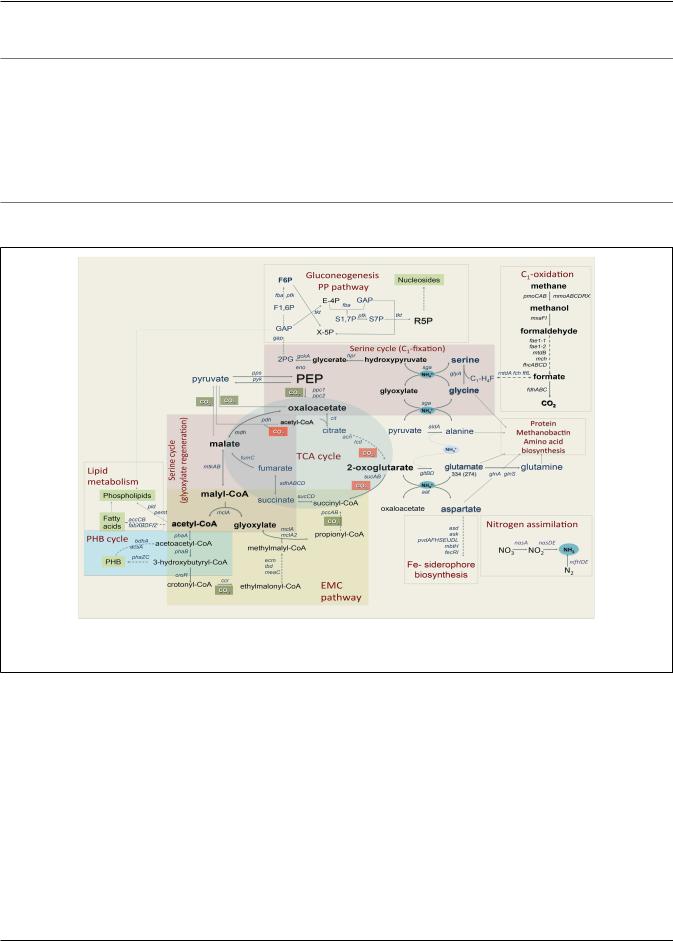
- •Introduction
- •Results and discussion
- •Gene expression studies
- •C1-oxidation: methane-to-methanol
- •C1-oxidation: methanol-to-formaldehyde
- •C1-oxidation: formaldehyde-to-formate
- •Formate oxidation
- •C1-assimilation: serine cycle
- •C1-assimilation: TCA cycle and anaplerotic CO2-fixation
- •Glycolysis/gluconeogenesis and pentose-phosphate pathways
- •Lipid metabolism
- •Nitrogen, copper, and iron metabolism
- •Conclusion
- •Materials and methods
- •Strain and cultivation conditions
- •Growth parameters and methane consumption rate measurements
- •Transcript sequencing, alignment, and mapping
- •Transcription site mapping and transcriptome based gene assembly
- •Acknowledgments
- •Supplementary material
- •References

Matsen et al. |
Methane utilization pathways in M. trichosporium OB3b |
|
|
integrated heterogeneous multi-scale genomic, transcriptomic, and metabolomic data to redefine the metabolic framework of C1-utilization in M. trichosporium OB3b grown in batch culture under copper, oxygen, and iron sufficiency on methane and nitrate as the sources of carbon and nitrogen, respectively. In this part of our work we present transcriptomic-based analysis of the methanotrophic metabolic network. Metabolomic and 13C-labeling studies are presented in a follow-up paper (Yang et al., 2013).
RESULTS AND DISCUSSION
GENE EXPRESSION STUDIES
Gene expression studies were carried out with M. trichosporium OB3b cultures grown on methane at N (10 mM), Cu (9 mM), and Fe (9 mM) sufficiency conditions. The maximum specific growth rate of M. trichosporium OB3b in shake flasks during the exponential growth phase was m D0.038 0.004 h 1. The methane consumption rate during the period of maximum growth rate was 8.95 mmol of CH4h 1 L culture 1 (OD600 D1).
All experiments were performed with at least two biological replicates. RNA samples were prepared as described in the Section “Materials and Methods.” Illumina sequencing for two biological replicates (BR1 and BR2) returned 28 and 29 million 36-bp reads. The Burrows–Wheeler Aligner (BWA, Li and Durbin, 2009) aligned 98% of the reads to the M. trichosporium OB3b genome annotated by MaGE1 using the default parameters for small genomes. Reads per kilobase of coding sequence per million (reads) mapped (RPKM) (Mortazavi et al., 2008) was calculated to compare gene expression within and across replicates, and no further normalization (other than RPKM) was applied. The samples were in good agreement with each other, with per gene coding sequence RPKM correlations of 0.959 and 0.989 for the Pearson and Spearman correlations, respectively. In total, 4,762 of 4,812 ORFs (CDS, tRNA, and rRNA predicted from the draft genome) were detected. Based on relative expression, genes (omitting rRNAs) could be grouped into six major expression categories (Table 1): very high (RPKM 15,000), high (RPKM 1,500), moderate (1,500 > RPKM 500), modest (500 > RPKM 250), low (250 > RPKM 150) very low (150 > RPKM 15), and not expressed (RPKM < 15). The majority of genes fell into low/very low expression categories (74%). About 14% of genes displayed moderate/modest expression and only a small fraction of the genome showed very high/high expression (2.7%).
In order to determine whether the draft genome of the strain is missing some functional genes, we performed de novo assembly of the transcriptome. Using this approach, a total of 173 genes that are not present in the genome sequence, but have homologs in the non-redundant database were detected. Among those are key subunits of succinate dehydrogenase (sdhABCD), 2-oxoglutarate dehydrogenase (E2), and nitric oxide reductase (norB) (Table S1 in Supplementary Material). The de novo transcriptome assembly provides additional information for highly expressed genes and it was used for verification of some metabolic functions that were predicted by enzymatic studies but were not detected in the draft genome assembly (see below).
1https://www.genoscope.cns.fr/agc/microscope/mage
Table 1 | Classification of gene expression level based on replicate averaged RPKMs.
Description of |
RPKM range |
% of ORFs |
Number of ORFs |
expression level |
|
|
|
|
|
|
|
Very high |
>15,000 |
0.23 |
11 |
High |
1,500–15,000 |
2.49 |
120 |
Moderate |
500–1,500 |
5.30 |
255 |
Modest |
250–500 |
8.61 |
414 |
Low |
50–250 |
40.41 |
1,944 |
Very low |
15–50 |
23.70 |
1,140 |
Not expressed |
<15 |
19.27 |
927 |
|
|
|
|
In addition, the reads obtained from RNA-seq were aligned to the reference genome in order to identify transcription boundaries and transcription start sites for the most highly expressed genes, including the pmoCAB operons, mxaFJGI operon, fae1, pqqA, and key genes of the serine cycle (Table S2 in Supplementary Material, see description below). Gene expression data were used to reconstruct central metabolic pathways in M. trichosporium OB3b (Table 2; Figure 1; Table S2 in Supplementary Material). Core functions are described below.
C1-OXIDATION: METHANE-TO-METHANOL
It has been previously demonstrated that M. trichosporium OB3b possesses two types of methane oxidation enzymes: pMMO and sMMO. The expression of the enzymes is determined by copper availability; sMMO is dominant in copper-limited environments while pMMO dominates under copper sufficiency (Hakemian and Rosenzweig, 2007; Semrau et al.,2010). Structures of both enzymes are available (Elango et al., 1997; Hakemian et al., 2008). In this study, M. trichosporium OB3b was grown at a copper concentration that has been shown to be sufficient to suppress the expression of sMMO (Park et al., 1991; Phelps et al., 1992; Nielsen et al., 1997; Lloyd et al., 1999; Murrell et al., 2000). Indeed, virtually no expression of the sMMO gene cluster (mmoXYBZC) was observed. In contrast, the pmoCAB genes were the most highly expressed in the transcriptome, representing about 14% of all reads mapped to the coding regions (Table 2). It has previously been shown that PMMO in M. trichosporium OB3b is encoded by two copies of the pmoCAB operon that appear to be identical (Gilbert et al., 2000). The current genome assembly failed to resolve these closely related duplicated regions. The pmoCAB genes were found within one relatively short contig, which includes 320 bp upstream from pmoC, and about 66 bp downstream from pmoB. It is possible that in the genome assembly, the pmo contig represents only those parts of the duplicated regions that are highly similar. Thus, it was not possible to determine relative expression of the two operons with the transcriptomic data.
Previous attempts to identify transcriptional starts of the pmoCAB operons in M. trichosporium OB3b using a conventional primer extension approach were not successful (Gilbert et al., 2000). The RNA-seq data were used for identification of transcriptional starts for the pmoCAB operons. Because the published METTOv1 genome did not contain a complete pmoCAB cluster, a separate alignment run was performed using a previously
Frontiers in Microbiology | Microbiological Chemistry |
April 2013 | Volume 4 | Article 40 | 2 |

Matsen et al. |
Methane utilization pathways in M. trichosporium OB3b |
|
|
Table 2 | Gene expression profile in methane-grown cells of M. trichosporium OB3b.
Gene ID |
Predicted function |
Gene |
Replicate 1 |
Replicate 2 |
|
|
|
|
|
|
|
|
|
|
METHANE AND METHANOL OXIDATION |
|
|
|
|
METTOv1_1270003 |
Particulate methane monooxygenase subunit C |
pmoC |
123026 |
127241 |
METTOv1_1270002 |
Particulate methane monooxygenase subunit A |
pmoA |
37102 |
31813 |
METTOv1_1270001 |
Particulate methane monooxygenase subunit B |
pmoB |
27371 |
22917 |
METTOv1_310040 |
Particulate methane monooxygenase subunit C2 |
pmoC2 |
532 |
492 |
METTOv1_50081 |
Soluble methane monooxygenase alpha subunit |
mmoX |
9 |
8 |
METTOv1_50082 |
Soluble methane monooxygenase beta subunit |
mmoY |
13 |
9 |
METTOv1_50084 |
Soluble methane monooxygenase gamma subunit |
mmoZ |
20 |
19 |
METTOv1_240014 |
PQQ-dependent methanol dehydrogenase |
mxaF |
15313 |
13760 |
METTOv1_240011 |
PQQ-dependent methanol dehydrogenase |
mxaI |
24552 |
28474 |
METTOv1_240012 |
Cytochrome c class I |
mxaG |
5712 |
6117 |
METTOv1_240013 |
Extracellular solute-binding protein family 3 |
mxaJ |
1942 |
1838 |
METTOv1_240001 |
Putative methanol utilization control sensor protein |
mxaY |
36 |
41 |
METTOv1_240002 |
Putative two-component response regulator |
mxaB |
303 |
317 |
METTOv1_240003 |
MxaH protein, involved in methanol oxidation |
mxaH |
399 |
391 |
METTOv1_240004 |
MxaD protein, involved in methanol oxidation |
mxaD |
1137 |
1077 |
METTOv1_240005 |
von Willebrand factor type A, involved in methanol oxidation |
mxaL |
191 |
201 |
METTOv1_240006 |
Protein of unknown function, involved in methanol oxidation |
mxaK |
124 |
132 |
METTOv1_240007 |
von Willebrand factor type A, involved in methanol oxidation |
mxaC |
144 |
141 |
METTOv1_240008 |
MxaA protein, involved in methanol oxidation |
mxaA |
137 |
127 |
METTOv1_240009 |
MxaS protein, involved in methanol oxidation |
mxaS |
202 |
167 |
METTOv1_240010 |
ATPase, involved in methanol oxidation |
mxaR |
563 |
538 |
METTOv1_110056 |
Coenzyme PQQ biosynthesis protein A |
pqqA |
11857 |
13927 |
METTOv1_160001 |
Coenzyme PQQ biosynthesis protein E |
pqqE |
166 |
161 |
METTOv1_160002 |
Coenzyme PQQ biosynthesis protein PqqC/D |
pqqC/D |
372 |
344 |
METTOv1_160003 |
Coenzyme PQQ biosynthesis protein B |
pqqB |
306 |
313 |
METTOv1_20046 |
Coenzyme PQQ biosynthesis protein F |
pqqF |
183 |
185 |
METTOv1_20047 |
Coenzyme PQQ biosynthesis protein G |
pqqG |
157 |
142 |
METTOv1_610028 |
Aldehyde dehydrogenase |
aldh |
37 |
37 |
METTOv1_290006 |
Aldehyde oxidase |
aor |
45 |
38 |
METTOv1_100046 |
Aldehyde dehydrogenase |
aldh-F7 |
7 |
9 |
|
|
|
|
|
FORMALDEHYDE OXIDATION |
|
|
|
|
METTOv1_40010 |
Methenyltetrahydromethanopterin cyclohydrolase |
mch |
393 |
312 |
METTOv1_40011 |
Tetrahydromethanopterin-linked C1 transfer pathway protein. Orf5 |
orf5 |
128 |
111 |
METTOv1_40012 |
Tetrahydromethanopterin-linked C1 transfer pathway protein, Orf7 |
orf7 |
73 |
72 |
METTOv1_40013 |
Formaldehyde activating enzyme |
fae1 |
24353 |
24787 |
METTOv1_40014 |
Formaldehyde activating enzyme |
fae1-2 |
4024 |
3676 |
METTOv1_840013 |
Formaldehyde activating enzyme homolog |
fae2 |
535 |
581 |
METTOv1_40015 |
Tetrahydromethanopterin-linked C1 transfer pathway protein |
orf17 |
38 |
45 |
METTOv1_110058 |
Tetrahydromethanopterin formyltransferase, subunit C |
fhcC |
535 |
453 |
METTOv1_110059 |
Tetrahydromethanopterin formyltransferase, subunit D |
fhcD |
496 |
470 |
METTOv1_110060 |
Tetrahydromethanopterin formyltransferase, subunit A |
fhcA |
591 |
546 |
METTOv1_110061 |
Tetrahydromethanopterin formyltransferase, subunit B |
fhcB |
620 |
570 |
METTOv1_560001 |
Tetrahydromethanopterin -linked C1 transfer pathway protein |
orf9 |
172 |
167 |
METTOv1_560002 |
Methylenetetrahydrofolate dehydrogenase (NAD) |
mtdB |
688 |
607 |
METTOv1_440045 |
Ribofuranosylaminobenzene 50-phosphate synthase |
mptG |
94 |
80 |
FORMATE OXIDATION |
|
|
|
|
METTOv1_630016 |
Transcriptional regulator, LysR family |
fdsR |
52 |
39 |
METTOv1_630017 |
NAD-linked formate dehydrogenase, subunit G |
fdsG |
672 |
608 |
METTOv1_630018 |
NAD-linked formate dehydrogenase, subunit B |
fdsB |
585 |
531 |
METTOv1_630019 |
NAD-linked formate dehydrogenase, subunit A |
fdsA |
593 |
554 |
METTOv1_370001 |
Formate dehydrogenase family accessory protein |
fdsC |
210 |
199 |
(Continued)
www.frontiersin.org |
April 2013 | Volume 4 | Article 40 | 3 |

Matsen et al. Methane utilization pathways in M. trichosporium OB3b
Table 2 | Continued
Gene ID |
Predicted function |
Gene |
Replicate 1 |
Replicate 2 |
|
|
|
|
|
METTOv1_370002 |
NAD-linked formate dehydrogenase, subunit D |
fdsD |
368 |
312 |
METTOv1_220028 |
NAD-linked formate dehydrogenase, subunit A |
fdhA2 |
9 |
7 |
|
|
|
|
|
C1-ASSIMILATION:SERINE CYCLE |
|
|
|
|
METTOv1_130002 |
Phosphoenolpyruvate carboxylase |
ppc2 |
104 |
89 |
METTOv1_400011 |
Glycerate kinase |
gckA |
229 |
211 |
METTOv1_400012 |
Conserved protein of unknown function |
orf1 |
626 |
708 |
METTOv1_400013 |
Malyl-CoA lyase/beta-methylmalyl-CoA lyase |
mclA |
1713 |
1615 |
METTOv1_400014 |
Phosphoenolpyruvate carboxylase |
ppc1 |
141 |
139 |
METTOv1_400015 |
Malate thiokinase, small subunit |
mtkB |
516 |
485 |
METTOv1_400016 |
Malate thiokinase, large subunit |
mtkA |
534 |
455 |
METTOv1_400017 |
Methenyltetrahydrofolate cyclohydrolase |
fch |
355 |
281 |
METTOv1_400018 |
NADP-dependent methylenetetrahydrofolate dehydrogenase |
mtdA |
281 |
243 |
METTOv1_400019 |
2-Hydroxyacid dehydrogenase NAD-binding |
hprA |
375 |
348 |
METTOv1_400020 |
Serine-glyoxylate transaminase |
sga |
1840 |
1969 |
METTOv1_400021 |
Formate-tetrahydrofolate ligase |
ftfL |
448 |
412 |
METTOv1_670019 |
Serine hydroxymethyltransferase |
glyA |
1342 |
1197 |
METTOv1_20135 |
Enolase |
eno |
432 |
408 |
|
|
|
|
|
C1-ASSIMILATION:EMP PATHWAY AND PHB CYCLE |
|
|
|
|
METTOv1_100079 |
Acetyl-CoA acetyltransferase |
phaA |
597 |
561 |
METTOv1_100080 |
Acetoacetyl-CoA reductase |
phaB |
1160 |
1060 |
METTOv1_50006 |
Crotonase |
croR |
235 |
275 |
METTOv1_110068 |
Crotonyl-CoA reductase |
ccr |
577 |
523 |
METTOv1_60013 |
Ethylmalonyl-CoA mutase |
ecm |
187 |
162 |
METTOv1_510010 |
Methylsuccinyl-CoA dehydrogenase |
ibd |
309 |
295 |
METTOv1_110043 |
Mesaconyl-CoA hydratase |
meaC |
341 |
317 |
METTOv1_30129 |
Methylmalonyl-CoA epimerase |
epm |
428 |
394 |
METTOv1_220010 |
Malyl-CoA lyase/beta-Methylmalyl-CoA lyase |
mclA2 |
137 |
135 |
METTOv1_200020 |
Acetyl/propionyl-CoA carboxylase |
ppcA |
353 |
310 |
METTOv1_220035 |
Propionyl-CoA carboxylase |
ppcB |
472 |
455 |
METTOv1_50067 |
Methylmalonyl-CoA mutase, large subunit |
mcmA |
201 |
188 |
METTOv1_10062 |
Methylmalonyl-CoA mutase small subunit B |
mcmB |
144 |
144 |
METTOv1_270063 |
3-Hydroxybutyrate dehydrogenase |
bdhA |
235 |
232 |
METTOv1_130047 |
Poly-beta-hydroxybutyrate polymerase |
phaC |
30 |
30 |
METTOv1_200042 |
Acetoacetate decarboxylase |
aad |
123 |
114 |
METTOv1_200022 |
Acetoacetyl-coenzyme A synthetase |
aas |
116 |
114 |
METTOv1_630008 |
Polyhydroxyalkanoate depolymerase |
phaZ |
237 |
263 |
|
|
|
|
|
C1-ASSIMILATION:TCA CYCLE |
|
|
|
|
METTOv1_360040 |
Malate dehydrogenase |
mdh |
539 |
473 |
METTOv1_360041 |
Succinyl-CoA synthetase, beta subunit |
sucC |
660 |
631 |
METTOv1_510003 |
Succinyl-CoA synthetase, alpha subunit |
sucD |
1198 |
1135 |
METTOv1_510002 |
2-Oxoglutarate dehydrogenase E1 |
sucA |
236 |
237 |
METTOv1_370050 |
2-Oxoglutarate dehydrogenase E2 |
sucB |
191 |
181 |
METTOv1_80046 |
Succinate:ubiquinone oxidoreductase |
sdhB |
327 |
348 |
METTOv1_80046 |
Succinate:ubiquinone oxidoreductase |
sdhA |
311 |
299 |
METTOv1_80051 |
Succinate:ubiquinone oxidoreductase, cytochrome b556 subunit |
sdhC |
318 |
329 |
METTOv1_40061 |
Fumarate hydratase |
fum |
196 |
185 |
METTOv1_1080004 |
2-Oxoacid ferredoxin oxidoreductase |
ofr |
79 |
77 |
|
|
|
|
|
INTERMEDIARY METABOLISM AND ANAPLEROTIC CO2-FIXATION |
|
|
|
|
METTOv1_70038 |
Phosphoenolpyruvate synthase |
pps |
28 |
26 |
METTOv1_120036 |
Pyruvate carboxylase |
pcx |
145 |
140 |
METTOv1_830002 |
Acetyl-coenzyme A carboxylase subunit beta |
accD |
246 |
228 |
METTOv1_380021 |
Acetyl-CoA carboxylase subunit alpha |
accA |
211 |
204 |
(Continued)
Frontiers in Microbiology | Microbiological Chemistry |
April 2013 | Volume 4 | Article 40 | 4 |

Matsen et al. Methane utilization pathways in M. trichosporium OB3b
Table 2 | Continued
Gene ID |
Predicted function |
Gene |
Replicate 1 |
Replicate 2 |
|
|
|
|
|
METTOv1_130018 |
Acetyl-CoA carboxylase, biotin carboxyl carrier protein |
accB |
307 |
276 |
METTOv1_150014 |
Pyruvate kinase |
pyk1 |
245 |
224 |
METTOv1_340039 |
Pyruvate dehydrogenase (acetyl-transferring) E1 |
pdhA |
181 |
175 |
METTOv1_340041 |
Pyruvate dehydrogenase subunit beta |
pdhB |
160 |
158 |
METTOv1_340042 |
Pyruvate dehydrogenase |
pdhC |
101 |
106 |
METTOv1_350050 |
Pyruvate phosphate dikinase |
pdk |
50 |
52 |
METTOv1_80025 |
Malic enzyme |
mae |
107 |
106 |
METTOv1_680013 |
Phosphoglycerate mutase |
gpmA |
136 |
135 |
METTOv1_100061 |
Phosphoglycerate mutase (modular protein) |
pgm |
101 |
99 |
METTOv1_10180 |
Phosphoglycerate mutase (modular protein) |
pgm |
72 |
65 |
METTOv1_280049 |
Phosphoglycerate kinase |
pgk |
199 |
208 |
METTOv1_280047 |
Glyceraldehyde-3-phosphate dehydrogenase |
gpd |
391 |
407 |
METTOv1_620016 |
Ribokinase |
rik |
140 |
144 |
METTOv1_620017 |
Phosphoribulokinase |
prk |
173 |
164 |
METTOv1_620018 |
Transketolase |
tkl |
147 |
123 |
METTOv1_620019 |
Fructose-bisphosphate aldolase, class II |
fba |
427 |
461 |
METTOv1_220030 |
6-Phosphofructokinase |
pfk |
243 |
239 |
METTOv1_200031 |
Fructose 1,6-bisphosphatase II |
glp |
68 |
56 |
METTOv1_550029 |
Glucose-6-phosphate isomerase |
pgi |
88 |
84 |
METTOv1_620022 |
Ribulose-phosphate 3-epimerase |
rpe |
51 |
53 |
|
|
|
|
|
NITROGEN, Cu, Fe METABOLISM |
|
|
|
|
METTOv1_310019 |
Nitrate transporter component |
nrtA |
151 |
154 |
METTOv1_310020 |
Nitrite reductase (NAD(P)H), large subunit |
nasB |
1762 |
1562 |
METTOv1_310021 |
Nitrite reductase (NAD(P)H), small subunit |
nasD |
726 |
610 |
METTOv1_310022 |
Nitrate reductase, large subunit |
nasA |
646 |
597 |
METTOv1_130049 |
Ammonium transporter |
amtB |
2029 |
1766 |
METTOv1_300058 |
Glutamate synthase large subunit (NADPH/GOGAT) |
gltB |
199 |
183 |
METTOv1_300033 |
Glutamate synthase small subunit (NADPH/GOGAT) |
gltD |
431 |
401 |
METTOv1_190023 |
Glutamate dehydrogenase |
gdh |
2 |
2 |
METTOv1_200046 |
Glutamate-ammonia ligase |
glnS |
1413 |
1375 |
METTOv1_200047 |
Nitrogen regulatory protein P-II |
glnK |
2400 |
2277 |
METTOv1_200048 |
Glutamine synthetase, type I |
glnA |
2452 |
2321 |
METTOv1_280018 |
Alanine dehydrogenase |
aldA |
29 |
36 |
METTOv1_80043 |
Phosphoserine aminotransferase |
serC |
415 |
364 |
METTOv1_560023 |
Cytochrome c0-alpha |
cycA |
336 |
370 |
METTOv1_230076 |
Putative oxygenase |
|
6 |
8 |
METTOv1_230077 |
Hydroxylamine reductase |
hcp |
21 |
16 |
METTOv1_230078 |
Putative transcriptional regulator |
nsrR |
38 |
35 |
METTOv1_730005 |
Putative FecR iron sensor protein |
fecR |
48 |
58 |
METTOv1_730006 |
Putative TonB-dependent receptor protein |
tonB |
382 |
383 |
METTOv1_CDS4222756D |
Methanobactin precursor |
Mb |
1439 |
2177 |
METTOv1_730007 |
Putative lyase |
|
306 |
384 |
METTOv1_730008 |
Conserved protein of unknown function |
hp |
170 |
175 |
METTOv1_730009 |
Conserved protein of unknown function |
hp |
116 |
143 |
METTOv1_660011 |
l-Ornithine 5-monooxygenase |
pvdA1 |
1410 |
1450 |
METTOv1_760004 |
Putative hydroxy-l-ornithine formylase |
pvdF |
2255 |
2676 |
METTOv1_760006 |
l-Ornithine 5-monooxygenase |
pvdA2 |
979 |
1116 |
METTOv1_760007 |
Diaminobutyrate-2-oxoglutarate aminotransferase |
pvdH |
720 |
770 |
METTOv1_760008 |
Sigma-24 (FecI-like) |
pvdS |
1260 |
1522 |
METTOv1_760009 |
Putative pyoverdine ABC export system, permease |
pvdE |
532 |
500 |
METTOv1_760010 |
TonB-dependent siderophore receptor |
fpvA |
2197 |
2174 |
METTOv1_760011 |
FecR-like protein |
fecR |
330 |
321 |
(Continued)
www.frontiersin.org |
April 2013 | Volume 4 | Article 40 | 5 |

Matsen et al. Methane utilization pathways in M. trichosporium OB3b
Table 2 | Continued
Gene ID |
Predicted function |
Gene |
Replicate 1 |
Replicate 2 |
|
|
|
|
|
METTOv1_760012 |
FecI-family sigma factor |
fecI |
922 |
951 |
METTOv1_870003 |
Ferribactin synthase |
pvdL |
433 |
441 |
METTOv1_870004 |
Pyoverdine biosynthesis regulatory protein-TauD/TfdA family protein |
|
932 |
1039 |
METTOv1_870005 |
Pyoverdine synthetase, thioesterase component |
pvdG |
1542 |
1473 |
METTOv1_870006 |
Integral components of bacterial non-ribosomal peptide synthetases |
MbtH |
4176 |
5481 |
METTOv1_1220001 |
Putative pyoverdine sidechain peptide synthetase IV, d-Asp-l-Ser component |
pvdI/J |
480 |
564 |
METTOv1_1220002 |
Putative non-ribosomal peptide synthase |
pvdJ/D |
379 |
396 |
Values represent reads per kilobase of coding sequence per million (reads) mapped (RPKM).
FIGURE 1 | Central metabolism of Methylosinus trichosporium OB3b grown on methane as sole source of energy and carbon as deduced from the genome sequences and transcriptomic studies. Font size of the gene name indicates the expression level.
published sequence as the scaffold (Holmes et al., 1995). For this sequence, two possible transcriptional start sites were identified. It is not known whether these reflect the same start sites of both operons, different start sites for each, or expression of only one operon with two start sites. The position 274nt (A) from the translational start of the pmoC gene was predicted as the most prominent start of transcription of the operon (Figure S1 in Supplementary Material). Putative s70-like -10 and -35 regions could be identified upstream of the predicted start (Table S3 in Supplementary Material). The structure of the putative promoter region from M. trichosporium OB3b shows significant similarity to a pmoCAB promoter region previously identified in Methylocystis sp. M (Gilbert et al., 2000). Another potential transcriptional start is at position 324 from the translational start of the pmoC gene. It should
be noted that the region between the two predicted start sites was also covered with relatively high count (region between 324 and 274nt with respect to the translational start of pmoC). No putative promoter sequences were found upstream of position 324.
The genome predicts an additional copy of the pmoC gene by itself (pmoC2, METTOv1_310040), which can be distinguished from the other pmoC genes in the transcriptomics data due to sequence divergence. It has previously been demonstrated that additional copies of pmoC are essential for methanotrophic growth in other strains (Stolyar et al., 1999; Dam et al., 2012a). It has also been shown that the homologous amoC (additional lone copy of amoC in ammonia-oxidizing bacterium Nitrosomonas europaea) plays role in cell recovery from ammonium starvation (Berube and Stahl, 2012). However the functional role of PmoC is
Frontiers in Microbiology | Microbiological Chemistry |
April 2013 | Volume 4 | Article 40 | 6 |
